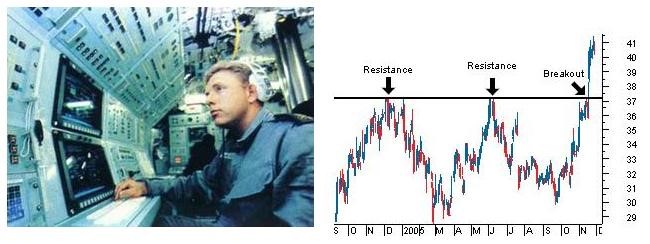The Collins Class Rule
Some long-term Marcus Today followers will remember the story about a Member who used to work in a Collins Class submarine on weapons systems (computer whizz). When they surfaced he would download stock-market data. When they submerged he would spend many hours of idle time back testing numbers looking for patterns in share price movements to see if anything systematically worked.

He found some 'edges' (identifying and buying into breakouts with short term trades became his thing) but one of the things he discovered was that, despite the reliability of his system, he still got nailed in market corrections and that whatever your system for stocks you always needed a sweeping market filter that would cover you for large quick market movements - something that forces you to look up from your stocks (the trees) to the market (the wood) and in so doing protect you when the whole wood moved suddenly.
After a lot of backtesting on why he sometimes got it all wrong, on why the systems broke down, on why he got caught out by ‘the market’ sometimes, he identified that corrections start fast and then trend and you had to have an unemotional mechanical strategy that pulled you out early on big market falls. He developed a filter that overrode all the rest of his systems which said that if the US market ever falls 3% in a day you sell half of everything and, if it does it again, you sell the rest.
We cashed up from 1.4% to 33% in the MT SMA on Wednesday 31st January, and then again to 60% on February 3rd, before the big falls, using this basic principle, that sometimes the market matters, that sometimes you have to gauge the herd not focus solely on stocks.
The Dow Jones had fallen 363 points on January 30 and then 665 on February 2. In prior days the volatility had picked up significantly with regular 200-400 point moves in both directions. Volatility is a sign that the market has become indecisive and that the market risks a change of trend. That new volatility was worrying us whilst, at the same time, the US market was going parabolic. That’s why we sold, in hindsight, in a very timely manner. The Collins Class Rule, sharp drops start trends and you need to react to them. We all need to keep the market in our peripheral vision at all times and look up from our stocks at times. The volatility was the sign. Volatility heralded the end of the Trump trend.
Where to now?
It’s all very well being right in hindsight but the only thing that matters now is what happens going forward and this smarmy “told you so” showing off is of no value if we can’t get that right.
- At the moment I am not debating whether to buy back yet, I am still wondering, in light of this continuing volatility, whether to sell everything after all. Trend changes start fast and then trend in the same direction. So, I am expecting this correction to continue, not miraculously turn on a sixpence. But it could.
- The best we can do in this game is to wake up every morning and make decisions based on the facts. It is not about making unmakeable predictions. That is the stuff of publicity seeking financial commentators who don't know they don't know, or do, but throw their predictions out anyway in an attempt to attract attention.
- It’s just the herd, that's all. I have seen a lot of talking heads floundering around in the last week, knowingly explaining exactly why the market has fallen over (interest rates going up in the US), but they are ignoring the most important factor, the herd. Sometimes the herd, when it is moving fast, can change direction just as swiftly. You don’t need an excuse, and in a world where over 50% of our trades are done by computers and there are trillions of dollars in exchange-traded funds which are robotic, we have never really experienced how savage this new electronic herd can be. All the more reason to stand back while nobody knows.
- There is no rush to buy. The market goes up slow and down fast. The bubble has burst, now it will take three times as long to build confidence as it took to lose it. You will have time. You are not about to miss the bottom. I can’t see this as an opportunity yet. It is not safe yet. All we have at the moment is the arrival of a storm.... this is not the time to push the boat out. Wait for the Sun to come out; you could still get sunk.
Conclusion
- Not buying yet.
- It is still highly risky.
- Still thinking of selling - if it still worries you sell something.
- Start making a list of stocks you will buy with the cash you have raised.
For balanced investors
For those of you who are conservative long-term/retiree investors who hold the standard balanced fund (say...10% cash, 15% fixed interest, 30% hybrids and 45% equities), you do not need to stress yourself. This is a correction (a small one in the local market so far) with little fundamental foundation other than the market was going up too fast. The herd is having a moment, but so far, that’s all.
There is no fundamental foundation to it so far (other than price, the market PE in the US is top of the historic range). If the commentary about US interest rates going up is the best we can come up with to explain the fall, then there isn’t much to worry about. We have known about US interest rates going up for months and months. Again, it is the herd reacting to price, not some shift in the fundamental backdrop. There is no sub-prime mortgage event hollowing out the foundations of our financial institutions. On the contrary, global GDP growth is still seeing a coordinated improvement, inflation is low, interest rates (even if they go up) are still benign and policy accommodation from central banks is still in place and, particularly in Europe, showing little sign of being removed. Company results are also solid, both in the US and in Australia (so far), and forecasts are on the rise and rising earnings numbers will steadily eat away at the top of the range market PEs.
In other words, we have a price issue in equities, but that’s about all.
In which case, while we, as equity-focused fund managers and commentators, talk about possibly selling everything, we are talking about the equity component only. For a balanced fund investor, who is only holding part of their investments in equities, there is little reason to worry. To upset the rest of your portfolio (which may account for 50-80% of your total fund) you would need a financial crisis that undermined the integrity of hybrids and fixed interest. We don’t have one. All we have is a hiccup in equity prices. That may warrant closing out some of your equity holdings (the Ritzy midcaps on high PEs), but otherwise, so far, there is very little to trouble the long-term, conservative, balanced investor/retiree.
I don’t imagine this correction will prove to be anything more than a healthy repricing of overpriced equities, which won’t include the underpriced equities like banks, utilities, infrastructure and REITS. Or hybrids or fixed interest.
So, relax. Sell a few high-priced equities maybe, but only to cash up a bit and provide the ammunition to raise your equity holdings again when the coast looks clear. There are so many great companies we wouldn't buy at the top but might sometime soon.
Marcus Padley is the author of the Marcus Today stock market newsletter. To sign up for a 14-day free trial please click here.
2 topics

